Research on the Spatial Expansion Characteristics and Industrial and Policy Driving Forces of Chengdu–Chongqing Urban Agglomeration Based on NPP-VIIRS Night Light Remote Sensing Data
Abstract
:1. Introduction
2. Materials and Methods
2.1. Research Area
2.2. Data Sources and Processing
2.2.1. Data Sources
2.2.2. Data Preprocessing
2.3. Research Methods
2.3.1. Measurement of Urban Built-up Area Expansion
2.3.2. Expansion Speed Index
2.3.3. Expansion Intensity Index
2.3.4. The Center of Gravity Offset
2.3.5. The Compact Degree
2.3.6. Fractal Dimension
2.3.7. Driving Force Study
3. Results
3.1. Analysis of the General Characteristics of Urban Agglomeration Expansion
3.2. Analysis of the Characteristics of Urban Agglomeration Expansion Scale
3.3. Analysis of the Morphological Characteristics of Urban Agglomeration Expansion
3.3.1. Change to the Center of Gravity of Urban Agglomeration
3.3.2. Analysis of the Results of Urban Spatial Form Characteristics
3.4. Analysis of Urban Expansion Driving Force
3.4.1. Analysis of Single Factor Detection Results
3.4.2. Interaction Detection Results
4. Discussion
4.1. Analysis of Urban Agglomeration Expansion Characteristics
4.1.1. Feasibility of Method Selection
4.1.2. Characteristics of Urban Agglomeration Expansion Scale
4.1.3. Morphological Characteristics of Urban Agglomeration Expansion
4.2. Analysis of Urban Expansion Driving Forces
5. Conclusions
Author Contributions
Funding
Institutional Review Board Statement
Informed Consent Statement
Data Availability Statement
Acknowledgments
Conflicts of Interest
Abbreviation
| SPOT | Système Probatoire d’Observation de la Terre |
| NDBI | Normalized Difference Built-up Index |
| NOAA | the National Oceanic and Atmospheric Administration |
| NGDC | the National Geophysical Data Center |
| Q value | q value is the degree of interpretation of the detection factor to urban expansion, with a range of [0, 1]. |
References
- Jiang, H.P.; Sun, Z.C.; Guo, H.; Weng, Q.; Du, W.; Xing, Q.; Cai, G. An assessment of urbanization sustainability in China between 1990 and 2015 using land use efficiency indicators. Npj Urban Sustain. 2021, 1, 34. [Google Scholar] [CrossRef]
- Jiang, Y.T.; Sun, S.K.; Zheng, S. Exploring Urban Expansion and Socioeconomic Vitality Using NPP-VIIRS Data in Xia-Zhang-Quan, China. Sustainability 2019, 11, 1739. [Google Scholar] [CrossRef] [Green Version]
- Liu, T.; Li, L. Green development of China’s Pan-Pearl River Delta mega-urban agglomeration. Sci. Rep. 2021, 11, 15717. [Google Scholar] [CrossRef] [PubMed]
- Bai, X.M.; Shi, P.J.; Liu, Y.S. Society. Realizing China’s urban dream. Nature 2014, 509, 158–160. [Google Scholar] [CrossRef] [Green Version]
- Zhang, L.; Yang, L.; Zohner, C.M.; Crowther, T.W.; Li, M.; Shen, F.; Guo, M.; Qin, J.; Yao, L.; Zhou, C. Direct and indirect impacts of urbanization on vegetation growth across the world’s cities. Sci. Adv. 2022, 8, eabo0095. [Google Scholar] [CrossRef]
- Zhong, Y.; Lin, A.; Zhou, Z. Evolution of the Pattern of Spatial Expansion of Urban Land Use in the Poyang Lake Ecological Economic Zone. Int. J. Environ. Res. Public Health 2019, 16, 117. [Google Scholar] [CrossRef] [Green Version]
- Duh, J.; Shandas, V.; Chang, H.; George, L.A. Rates of urbanisation and the resiliency of air and water quality. Sci. Total Environ. 2008, 400, 238–256. [Google Scholar] [CrossRef]
- Wang, J.T.; Qu, S.Y.; Peng, K.; Feng, Y. Quantifying Urban Sprawl and Its Driving Forces in China. Discret. Dyn. Nat. Soc. 2019, 2019, 2606950. [Google Scholar] [CrossRef]
- Chen, J.D.; Gao, M.; Cheng, S.L.; Liu, X.; Hou, W.; Song, M.; Li, D.; Fan, W. China’s city-level carbon emissions during 1992–2017 based on the inter-calibration of nighttime light data. Sci. Rep. 2021, 11, 3323. [Google Scholar] [CrossRef]
- Chen, G.Z.; Li, X.; Liu, X.P. Global projections of future urban land expansion under shared socioeconomic pathways. Nat. Commun. 2020, 11, 537. [Google Scholar] [CrossRef]
- Bianchini, L.; Marucci, A.; Sateriano, A.; Di Stefano, V.; Alemanno, R.; Colantoni, A. Urbanization and Long-Term Forest Dynamics in a Metropolitan Region of Southern Europe (1936–2018). Sustainability 2021, 13, 12164. [Google Scholar] [CrossRef]
- Krayenhoff, E.S.; Moustaoui, M.; Broadbent, A.M.; Gupta, V.; Georgescu, M. Diurnal interaction between urban expansion, climate change and adaptation in US cities. Nat. Clim. Change 2018, 8, 1097–1103. [Google Scholar] [CrossRef]
- Sahana, M.; Hong, H.Y.; Sajjad, H. Analyzing urban spatial patterns and trend of urban growth using urban sprawl matrix: A study on Kolkata urban agglomeration, India. Sci. Total Environ. 2018, 628–629, 1557–1566. [Google Scholar] [CrossRef]
- Zhang, C.; Miao, C.H.; Zhang, W.H.; Chen, X. Spatiotemporal patterns of urban sprawl and its relationship with economic development in China during 1990–2010. Habitat Int. 2018, 79, 51–60. [Google Scholar] [CrossRef]
- Chen, C.; He, X.Y.; Liu, Z.S.; Sun, W.; Dong, H.; Chu, Y. Analysis of regional economic development based on land use and land cover change information derived from Landsat imagery. Sci. Rep. 2020, 10, 12721. [Google Scholar] [CrossRef]
- Leyk, S.; Uhl, J.H.; Connor, D.S.; Braswell, A.E.; Mietkiewicz, N.; Balch, J.K.; Gutmann, M. Two centuries of settlement and urban development in the United States. Sci. Adv. 2020, 6, eaba2937. [Google Scholar] [CrossRef]
- Zheng, Y.M.; He, Y.R.; Zhou, Q.; Wang, H. Quantitative Evaluation of Urban Expansion using NPP-VIIRS Nighttime Light and Landsat Spectral Data. Sustain. Cities Soc. 2022, 76, 103338. [Google Scholar] [CrossRef]
- Kyba, C.C.M.; Kuester, T.; de Miguel, A.S.; Baugh, K.; Jechow, A.; Hölker, F.; Bennie, J.; Elvidge, C.D.; Gaston, K.J.; Guanter, L. Artificially lit surface of Earth at night increasing in radiance and extent. Sci. Adv. 2017, 3, e1701528. [Google Scholar] [CrossRef] [Green Version]
- Chen, J.D.; Liu, J.L.; Qi, J.; Gao, M.; Cheng, S.; Li, K.; Xu, C. City- and county-level spatio-temporal energy consumption and efficiency datasets for China from 1997 to 2017. Sci. Data 2022, 9, 101. [Google Scholar] [CrossRef]
- Xu, L.H. Spatial and Temporal Evolution of urban Expansion in Yangtze River Delta Based on NPP-VIIRS Data. Master’s Thesis, Shanghai Normal University, Shanghai, China, 1 March 2019. [Google Scholar]
- Duque, J.C.; Lozano-Gracia, N.; Patino, J.E.; Restrepo, P.; Velasquez, W.A. Spatiotemporal dynamics of urban growth in Latin American cities: An analysis using nighttime light imagery. Landsc. Urban Plan. 2019, 191, 103640. [Google Scholar] [CrossRef]
- Chen, Z.Q.; Yu, B.L.; Zhou, Y.Y.; Liu, H.; Yang, C.; Shi, K.; Wu, J. Mapping Global Urban Areas From 2000 to 2012 Using Time-Series Nighttime Light Data and MODIS Products. IEEE J. Sel. Top. Appl. Earth Obs. Remote Sens. 2019, 12, 1143–1153. [Google Scholar] [CrossRef]
- Chen, J.Q.; Wei, H.; Li, N.; Chen, S.; Qu, W.; Zhang, Y. Exploring the Spatial-Temporal Dynamics of the Yangtze River Delta Urban Agglomeration Based on Night-Time Light Remote Sensing Technology. IEEE J. Sel. Top. Appl. Earth Obs. Remote Sens. 2020, 13, 5369–5383. [Google Scholar] [CrossRef]
- Zhao, M.; Zhou, Y.Y.; Li, X.; Zhou, C.; Cheng, W.; Li, M.; Huang, K. Building a Series of Consistent Night-Time Light Data (1992–2018) in Southeast Asia by Integrating DMSP-OLS and NPP-VIIRS. IEEE Trans. Geosci. Remote Sens. 2020, 58, 1843–1856. [Google Scholar] [CrossRef]
- Liu, Z.F.; He, C.Y.; Zhang, Q.; Huang, Q.; Yang, Y. Extracting the dynamics of urban expansion in China using DMSP-OLS nighttime light data from 1992 to 2008. Landsc. Urban Plan. 2012, 106, 62–72. [Google Scholar] [CrossRef]
- Zhou, Y.; Li, L. Spatial and Temporal Patterns of urbanization in Chengdu Plain Urban Agglomeration: A Study based on DMSP/OLS night light Data. Urban Dev. Res. 2015, 22, 28–32. [Google Scholar]
- Liu, Y.; Li, Y.C. Extraction and Analysis of urban Center Area Based on Night Light Data: A case study of Chongqing City. Compr. Resour. Util. China 2019, 37, 160–164. [Google Scholar]
- Liu, Q.Y.; Fan, J.P. Analysis of Chengdu-Chongqing Urban Agglomeration expansion under consistency correction of night light Remote sensing data. Sci. Surv. Mapp. 2022, 47, 99–108. [Google Scholar]
- Yang, R.F.; Luo, H.X. Reconstruction and Analysis of the spatial Formation Process of Chengdu-Chongqing urban Agglomeration Driven by night light data. J. Geo-Inf. Sci. 2017, 19, 653–661. [Google Scholar]
- Levin, N.; Kyba, C.C.; Zhang, Q.; de Miguel, A.S.; Román, M.O.; Li, X.; Portnov, B.A.; Molthan, A.L.; Jechow, A.; Miller, S.D.; et al. Remote sensing of night lights: A review and an outlook for the future. Remote Sens. Environ. 2020, 237, 111443. [Google Scholar] [CrossRef]
- Pu, Y.X.; Ma, R.H. Spatial and temporal evolution of urban size distribution in the Yangtze River Delta. Geogr. Res. 2009, 28, 161–172. [Google Scholar]
- Xie, Y.H.; Weng, Q.H. Updating urban extents with nighttime light imagery by using an object-based thresholding method. Remote Sens. Environ. 2016, 187, 1–13. [Google Scholar] [CrossRef]
- Zhong, Y.; Lin, A.W.; He, L.; Zhou, Z.; Yuan, M. Spatiotemporal Dynamics and Driving Forces of Urban Land-Use Expansion: A Case Study of the Yangtze River Economic Belt, China. Remote Sens. 2020, 12, 287. [Google Scholar] [CrossRef] [Green Version]
- Liu, S.H.; Li, X.B. Spatial patterns of urban land use growth in Beijing. J. Geogr. Sci. 2002, 12, 266–274. [Google Scholar]
- Wang, H.J.; Zhang, B. Multi-dimensional analysis of urban expansion pattern and driving force of Beijing-Tianjin-Hebei Urban Agglomeration based on barycentric GTWR model. Acta Geogr. Sin. 2018, 73, 1076–1092. [Google Scholar]
- Guan, X.L.; Fang, C.L. Spatial and Temporal Characteristics of urban land expansion in Wuhan Urban Agglomeration. J. Nat. Resour. 2012, 27, 1447–1459. [Google Scholar]
- Liu, H.X.; Zhu, K.W.; Li, Y.C. Urban Expansion in Chengdu-Chongqing Economic Zone in Recent 20 Years: Based on DMSP/OLS Night Light Data. J. Chongqing Norm. Univ. 2017, 34, 117–126. [Google Scholar]
- Liu, J.Y.; Wang, X.S. Convex hull Principle is used to identify types of urban land space expansion. Acta Geogr. Sin. 2003, 06, 885–892. [Google Scholar]
- Batty, M. Exploring Isovist Fields: Space and Shape in Architectural and Urban Morphology. Environ. Plan. B Plan. Des. 2001, 28, 123–150. [Google Scholar] [CrossRef] [Green Version]
- Xu, J.J.; Zang, S.Y. Characteristics and Driving Forces of urban expansion in Harbin. Bull. Surv. Mapp. 2019, 09, 68–72. [Google Scholar]
- Zhou, Z.H.; Ren, Y.Y. Analysis of Urban Spatial Morphology Characteristics in Wuwei from 1990 to 2016. Ind. Archit. 2020, 50, 120–126. [Google Scholar]
- Du, H.B.; Wei, W. Spatial and temporal patterns of carbon emissions from energy consumption in the Yellow River Basin and their influencing factors: Based on DMSP/OLS and NPP/VIIRS night light data. Geogr. Resaust. 2021, 40, 2051–2065. [Google Scholar]
- Niu, Y.W.; Zhao, X.C. Spatial differentiation of land use carbon emissions in Changzhutan County based on NPP-VIIRS nighttime lighting. J. Environ. Sci. 2021, 41, 3847–3856. [Google Scholar]
- Shi, K.F.; Huang, C.; Yu, B.; Yin, B.; Huang, Y.; Wu, J. Evaluation of NPP-VIIRS night-time light composite data for extracting built-up urban areas. Remote Sens. Lett. 2014, 5, 358–366. [Google Scholar] [CrossRef]
- Zhang, Z.W.; Liu, Y.F. Spatial Expansion and Correlation of Urban Agglomeration in the Yellow River Basin Based on Multi-Source Nighttime Light Data. Sustainability 2022, 14, 9359. [Google Scholar] [CrossRef]
- Zhang, H.; Liang, C.; Pan, Y. Spatial Expansion of Built-Up Areas in the Beijing–Tianjin–Hebei Urban Agglomeration Based on Nighttime Light Data: 1992–2020. IJERPH 2022, 19, 3760. [Google Scholar] [CrossRef]
- Zheng, W.S.; Kuang, A.P.; Liu, Z.; Wang, X. Analysing the spatial structure of urban growth across the Yangtze River Middle reaches urban agglomeration in China using NPP-VIIRS night-time lights data. GeoJournal 2021, 87, 2753–2770. [Google Scholar] [CrossRef]
- Li, J.F.; Pan, J.H. Urban Spatial Expansion in Gansu Province from 1992 to 2012 Based on Night Light. J. Glaciol. Geocryol. 2016, 38, 829–835. [Google Scholar]
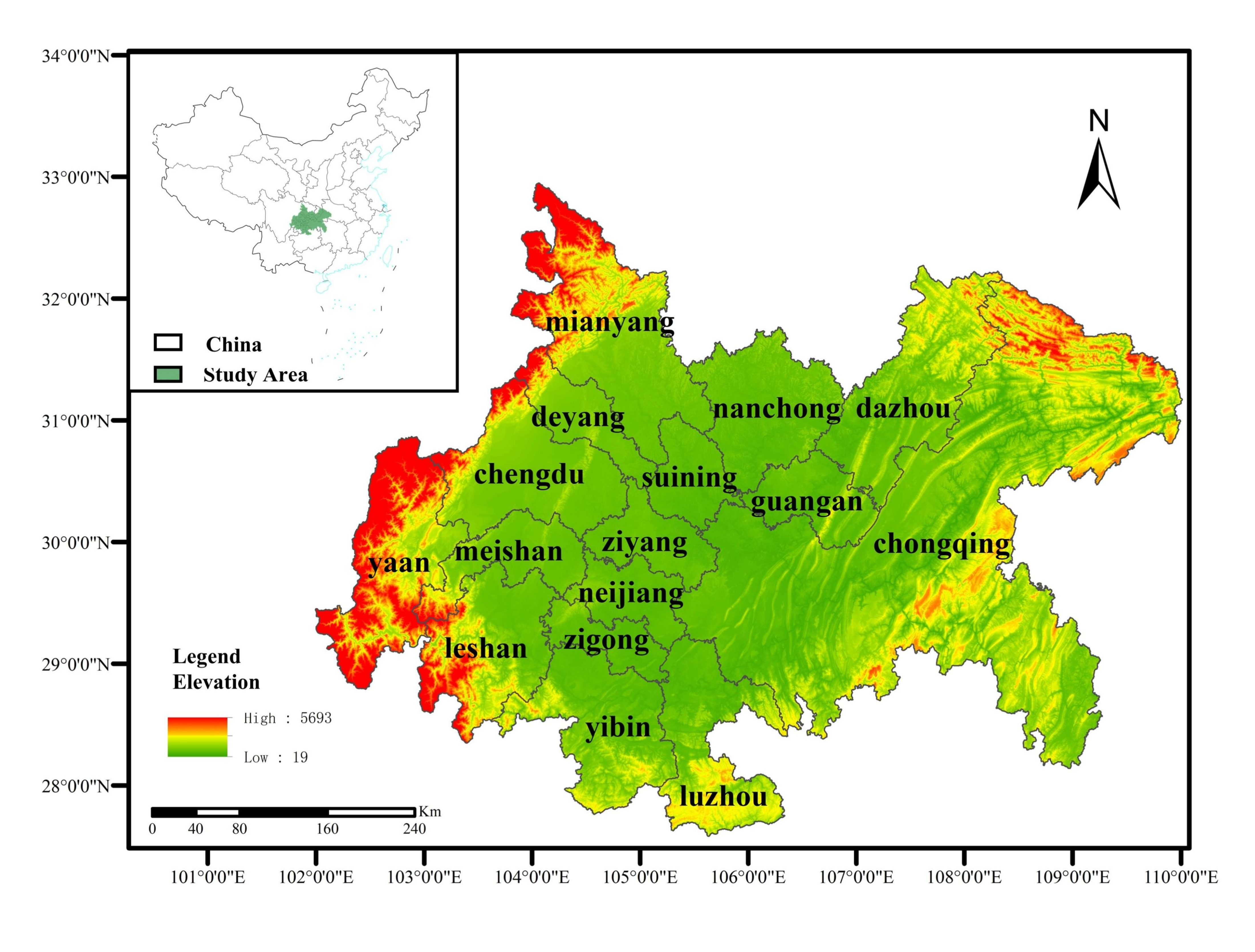
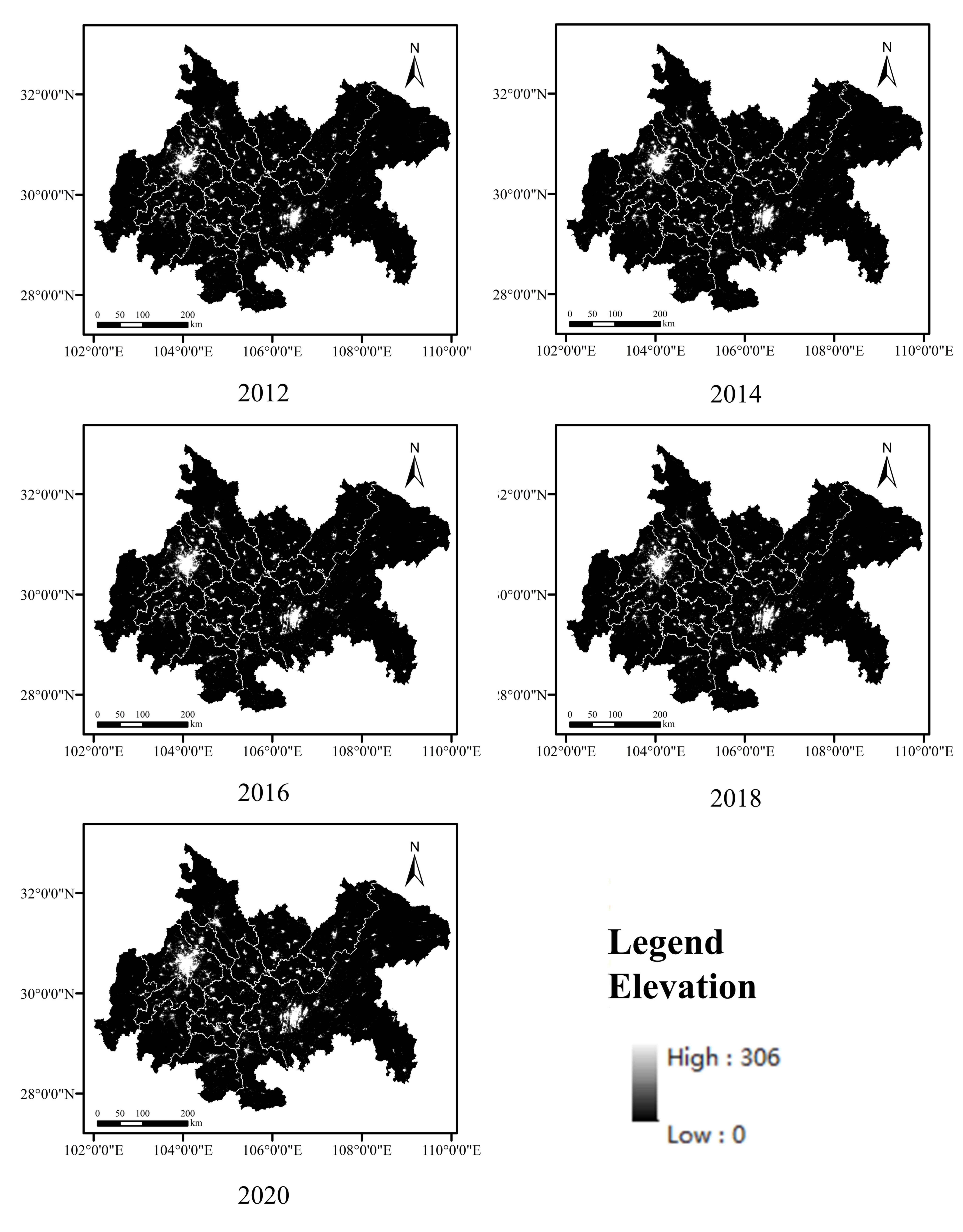
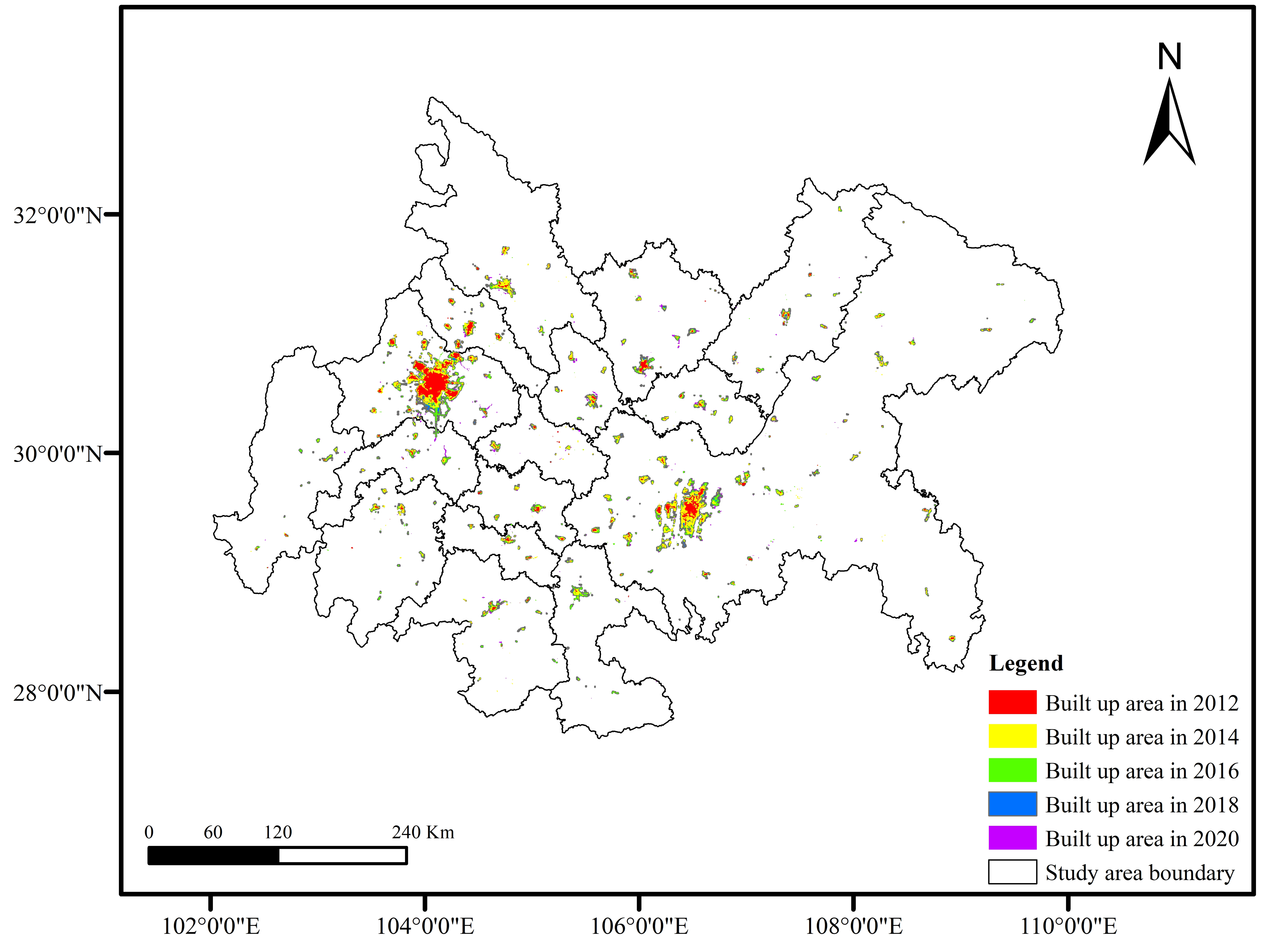

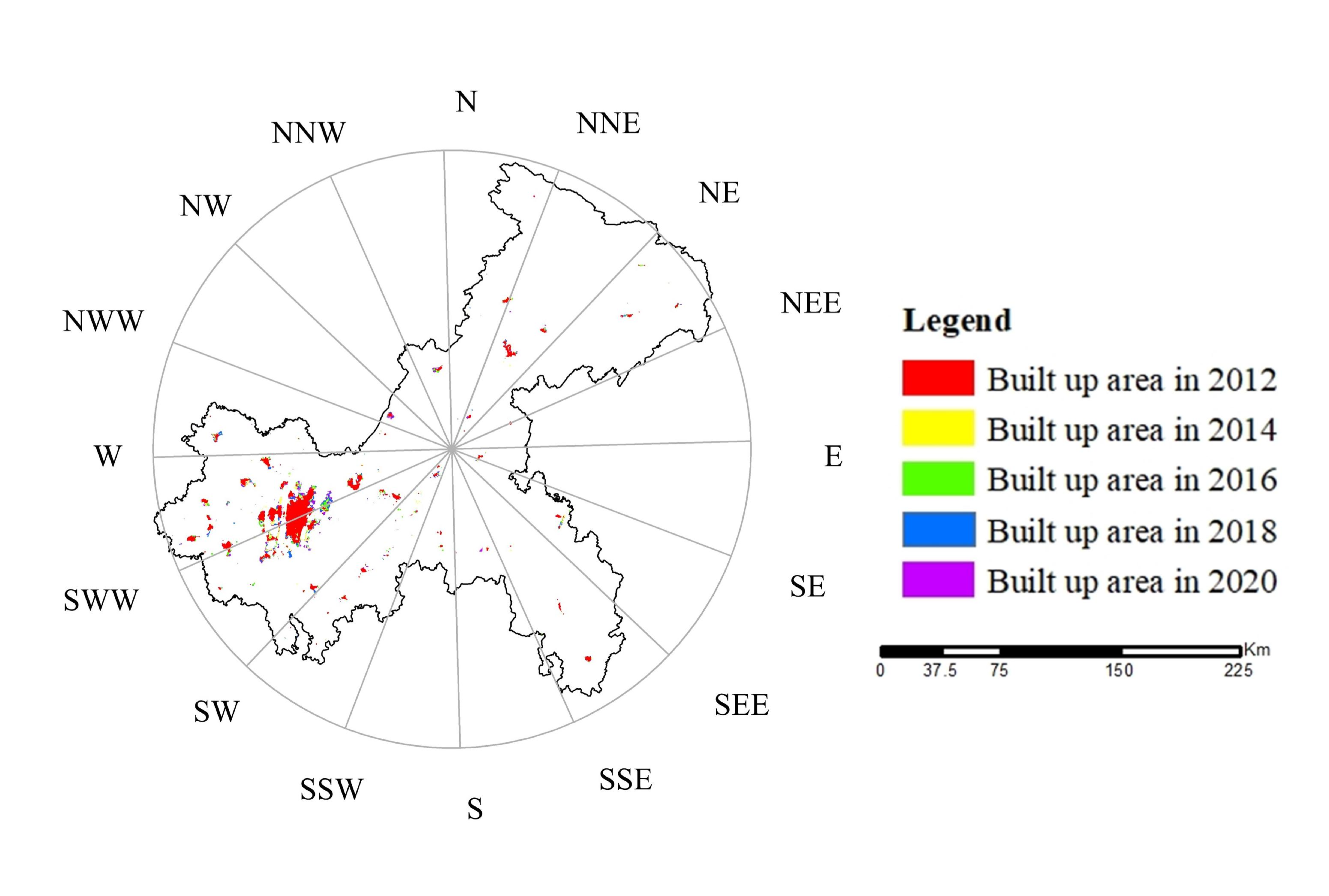
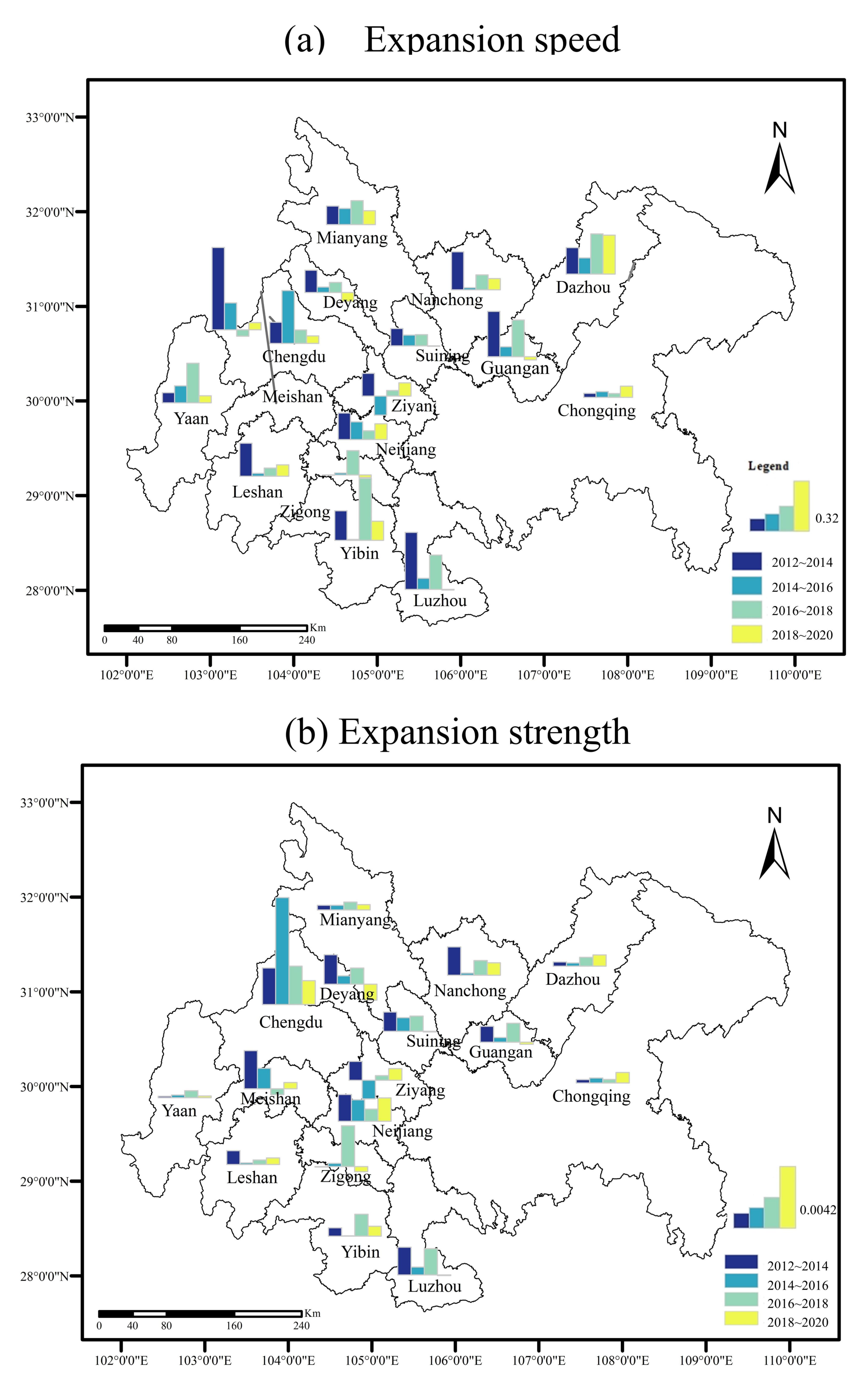
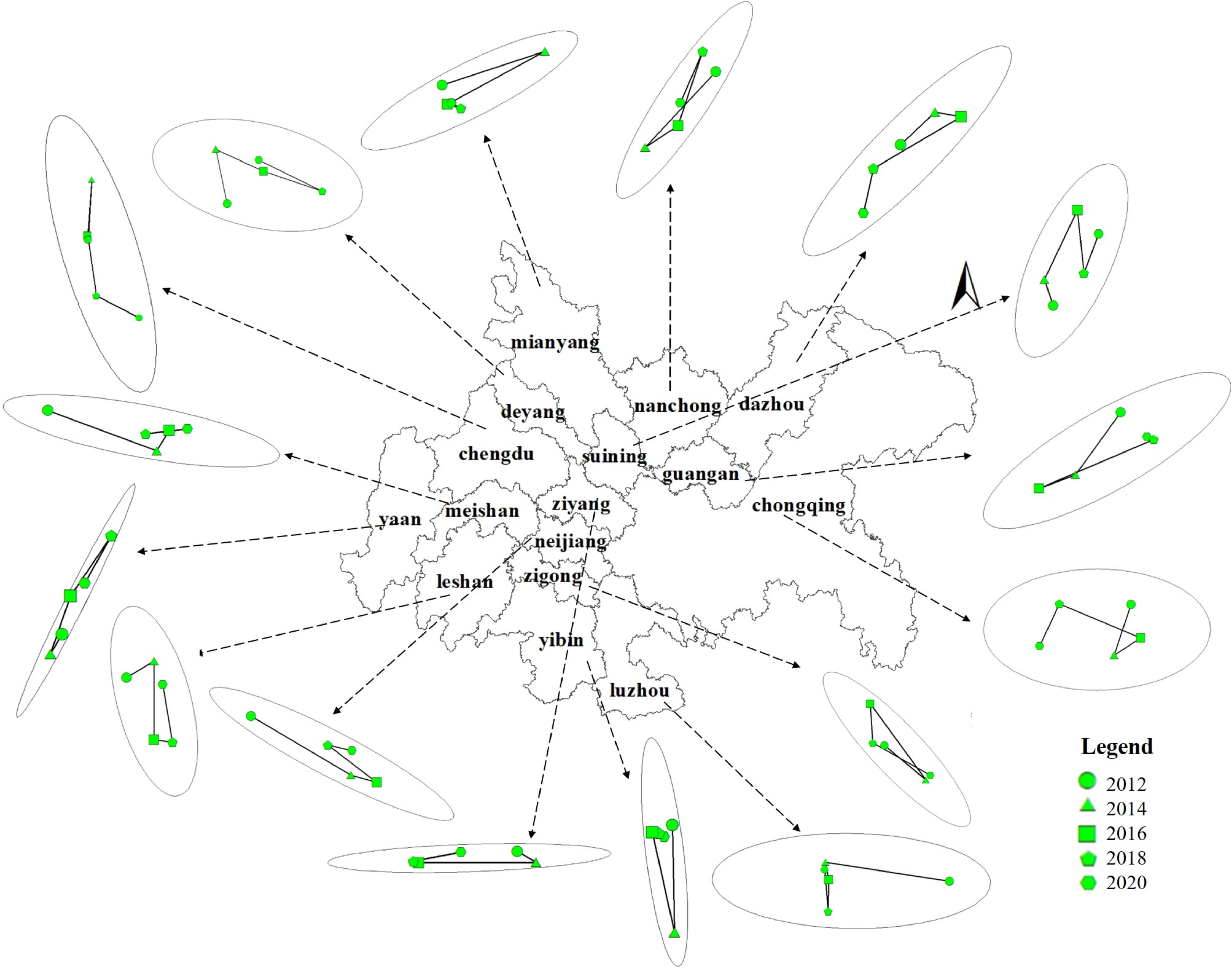
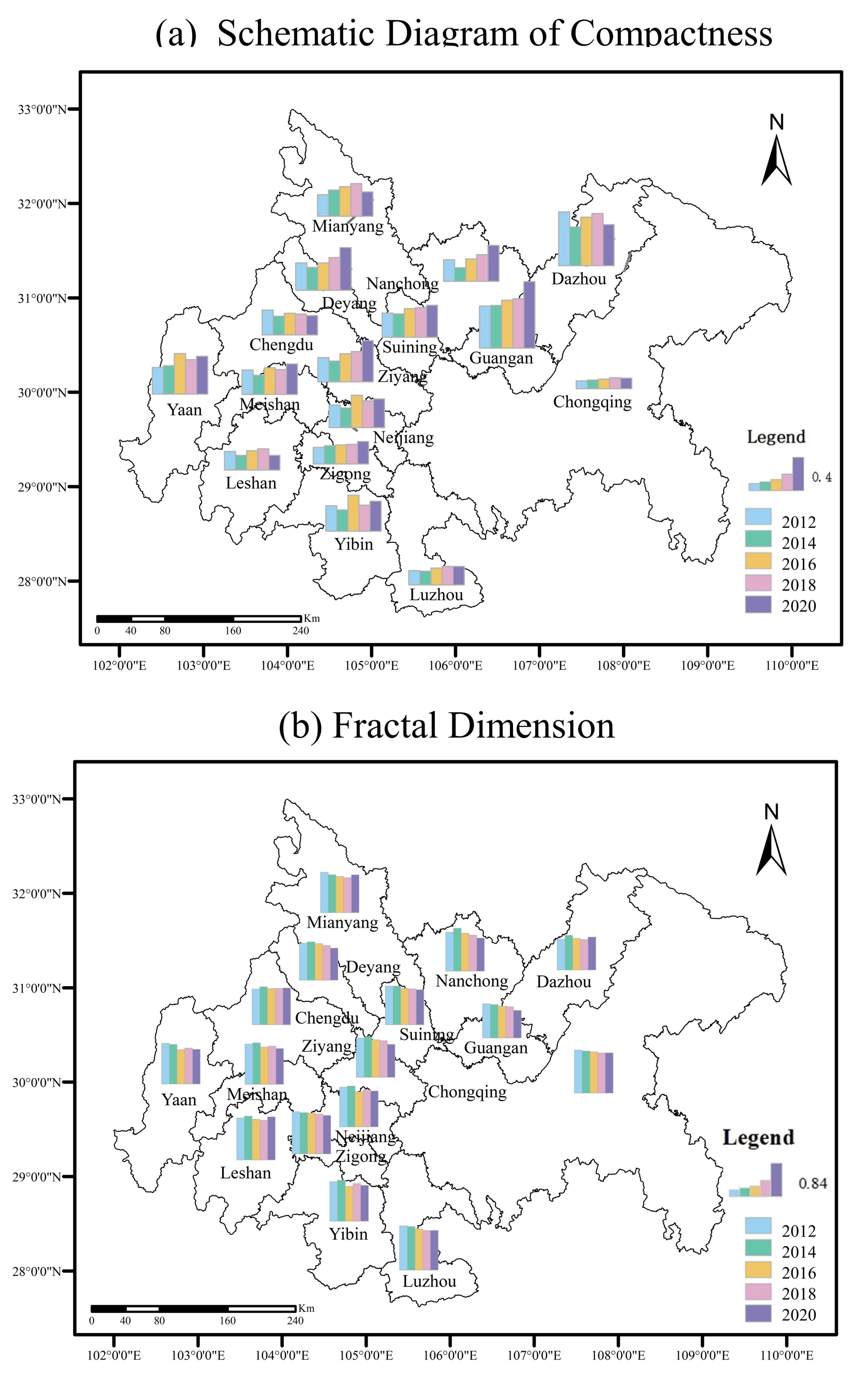
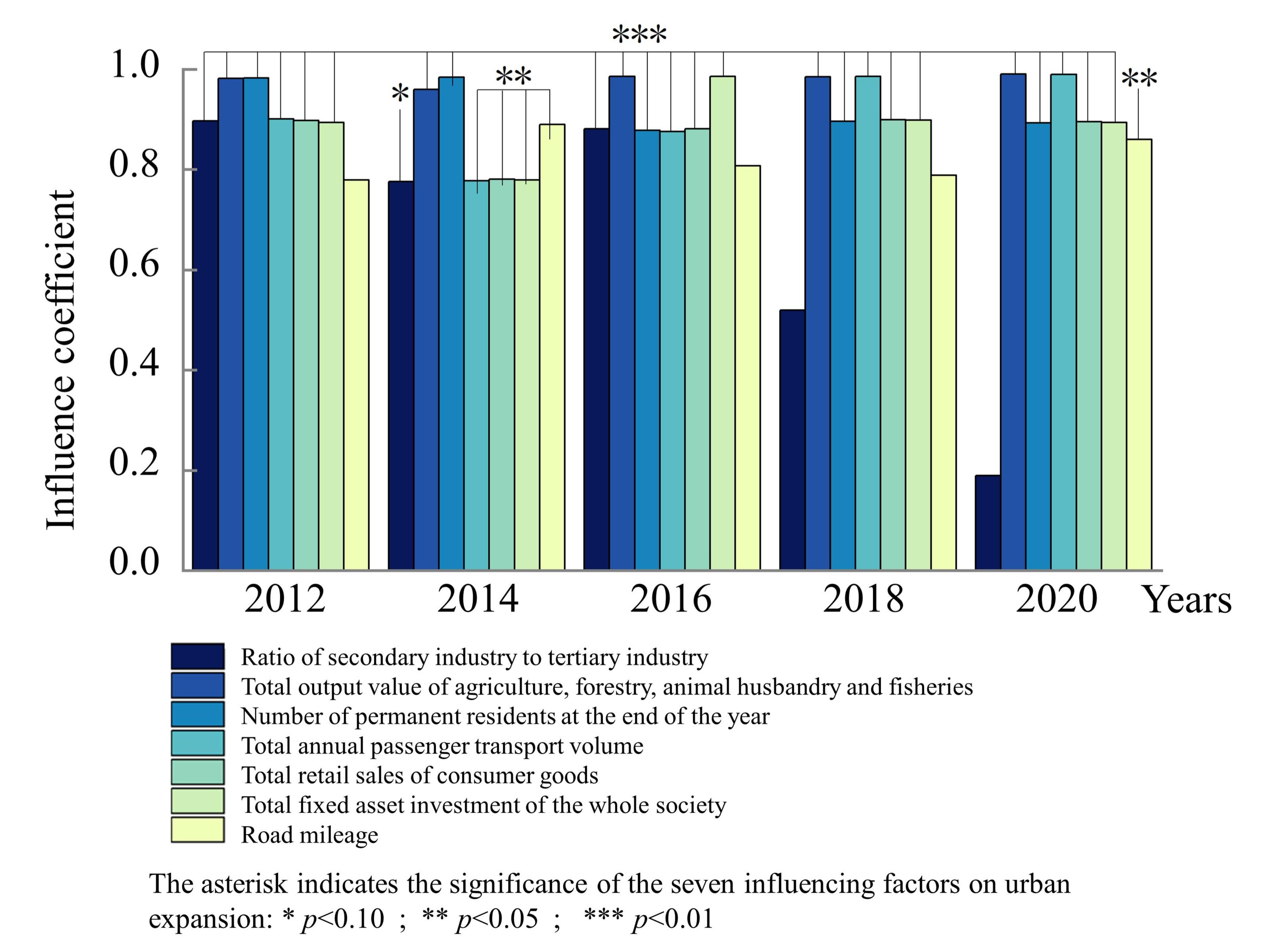
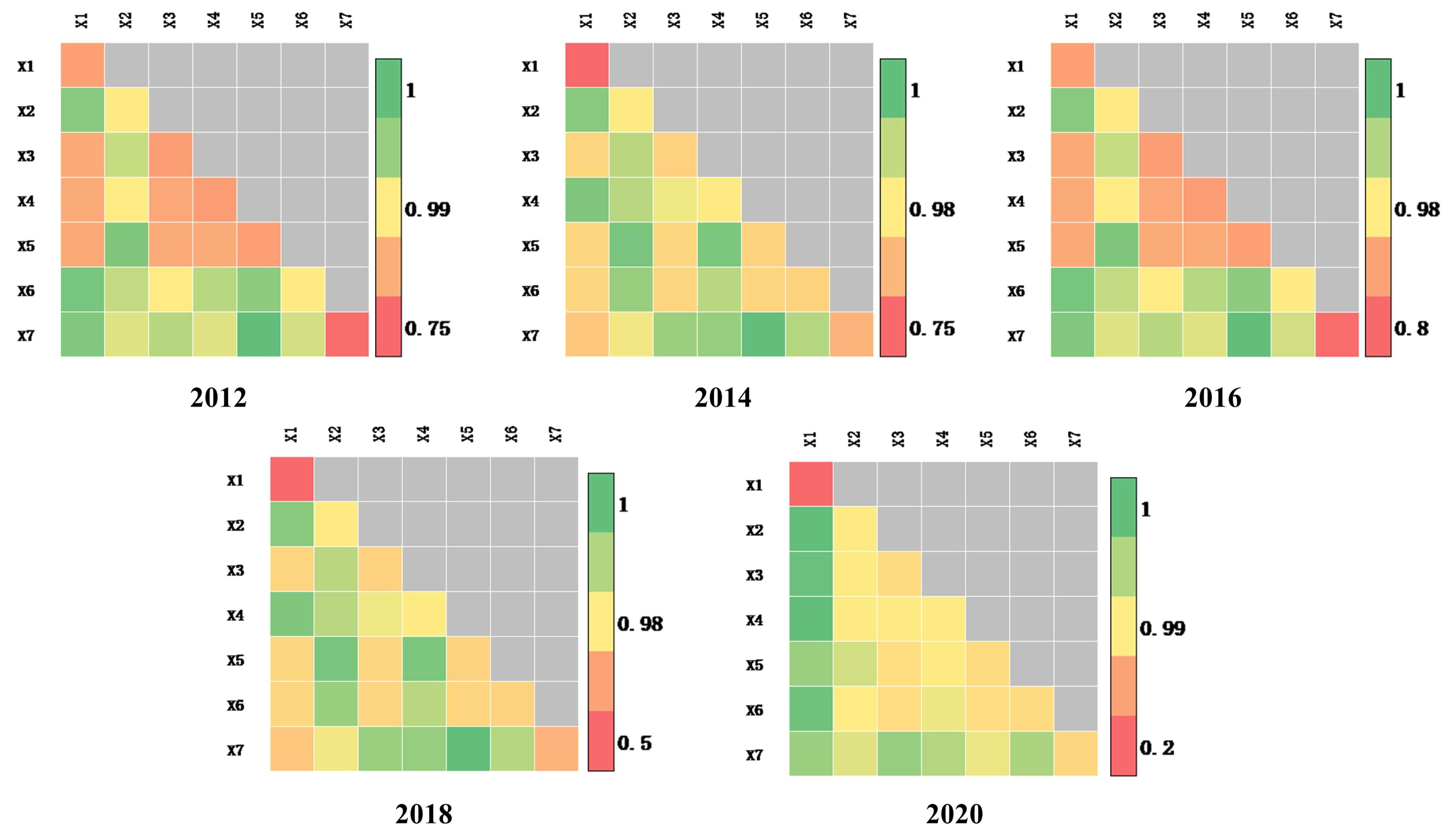
| Target Layer | Feature Layer | Indicator Layer |
|---|---|---|
| Indicators of factors influencing urban expansion | Economic development level | Ratio of secondary industry to tertiary industry |
| Total output value of agriculture, forestry, animal husbandry, and fisheries (100 million yuan) | ||
| Population size | Number of permanent residents at the end of the year (10,000 persons) | |
| Total annual passenger transport volume (10,000 persons) | ||
| Regional investment level | Total retail sales of consumer goods (100 million yuan) | |
| Total fixed asset investment of the whole society (100 million yuan) | ||
| Transportation development level | Road mileage (km) |
| Year | Statistical Area (km2) | Extraction Area (km2) | Relative Error |
|---|---|---|---|
| 2012 | 3334.58 | 3342.35 | −0.23% |
| 2014 | 3819.67 | 3797.79 | 0.57% |
| 2016 | 4226.39 | 4210.99 | 0.36% |
| 2018 | 4727.99 | 4627.96 | 2.12% |
| 2020 | 5007.17 | 4943.29 | 1.28% |
| City | Distance (Km) and Angle (°) of Gravity Center Shift | |||||||
|---|---|---|---|---|---|---|---|---|
| 2012–2014 | 2014–2016 | 2016–2018 | 2018–2020 | |||||
| Chengdu | 2.414 | −86 | 2.435 | 94 | 2.638 | 82 | 2.091 | 27 |
| Chongqing | 6.311 | 108 | 3.736 | −33 | 10.433 | −157 | 5.513 | 115 |
| Zigong | 6.451 | 40 | 11.296 | −126 | 4.717 | 86 | 7.923 | 29 |
| Luzhou | 47.246 | −171 | 6.651 | 80 | 11.991 | 91 | 15.770 | −95 |
| Deyang | 3.631 | −102 | 3.467 | 25 | 4.069 | 19 | 4.650 | −154 |
| Mianyang | 19.281 | −18 | 19.765 | 152 | 2.844 | 16 | 1.945 | −150 |
| Suining | 2.737 | −109 | 7.656 | −65 | 6.307 | 84 | 4.160 | −70 |
| Neijiang | 25.4 | 31 | 5.921 | 16 | 13.466 | −143 | 5.382 | 13 |
| Leshan | 10.196 | −31 | 24.999 | 90 | 5.917 | 7 | 18.578 | −100 |
| Dazhou | 7.875 | −44 | 4.44 | 11 | 12.9 | 149 | 7.620 | 103 |
| Nanchong | 21.026 | 133 | 8.015 | −33 | 15.88 | −72 | 11.356 | 114 |
| Meishan | 18.963 | 20 | 3.847 | −59 | 3.884 | −172 | 6.894 | −7 |
| Yibin | 33.202 | 89 | 31.717 | −103 | 2.161 | 7 | 1.803 | 34 |
| Guangan | 8.103 | 126 | 4.076 | −160 | 13.082 | −23 | 0.750 | −159 |
| Ya’an | 10.991 | 121 | 29.27 | −71 | 34.783 | −56 | 26.013 | 119 |
| Ziyang | 8.438 | 30 | 45.441 | 180 | 2.023 | −161 | 18.711 | −11 |
| ALL | 5.236 | −9 | 27.286 | 29 | 8.118 | −60 | 36.464 | 32 |
Disclaimer/Publisher’s Note: The statements, opinions and data contained in all publications are solely those of the individual author(s) and contributor(s) and not of MDPI and/or the editor(s). MDPI and/or the editor(s) disclaim responsibility for any injury to people or property resulting from any ideas, methods, instructions or products referred to in the content. |
© 2023 by the authors. Licensee MDPI, Basel, Switzerland. This article is an open access article distributed under the terms and conditions of the Creative Commons Attribution (CC BY) license (https://creativecommons.org/licenses/by/4.0/).
Share and Cite
Wei, Y.; Li, Y.; Wang, S.; Wang, J.; Zhu, Y. Research on the Spatial Expansion Characteristics and Industrial and Policy Driving Forces of Chengdu–Chongqing Urban Agglomeration Based on NPP-VIIRS Night Light Remote Sensing Data. Sustainability 2023, 15, 2188. https://doi.org/10.3390/su15032188
Wei Y, Li Y, Wang S, Wang J, Zhu Y. Research on the Spatial Expansion Characteristics and Industrial and Policy Driving Forces of Chengdu–Chongqing Urban Agglomeration Based on NPP-VIIRS Night Light Remote Sensing Data. Sustainability. 2023; 15(3):2188. https://doi.org/10.3390/su15032188
Chicago/Turabian StyleWei, Yali, Ying Li, Siying Wang, Junyi Wang, and Yu Zhu. 2023. "Research on the Spatial Expansion Characteristics and Industrial and Policy Driving Forces of Chengdu–Chongqing Urban Agglomeration Based on NPP-VIIRS Night Light Remote Sensing Data" Sustainability 15, no. 3: 2188. https://doi.org/10.3390/su15032188
APA StyleWei, Y., Li, Y., Wang, S., Wang, J., & Zhu, Y. (2023). Research on the Spatial Expansion Characteristics and Industrial and Policy Driving Forces of Chengdu–Chongqing Urban Agglomeration Based on NPP-VIIRS Night Light Remote Sensing Data. Sustainability, 15(3), 2188. https://doi.org/10.3390/su15032188





